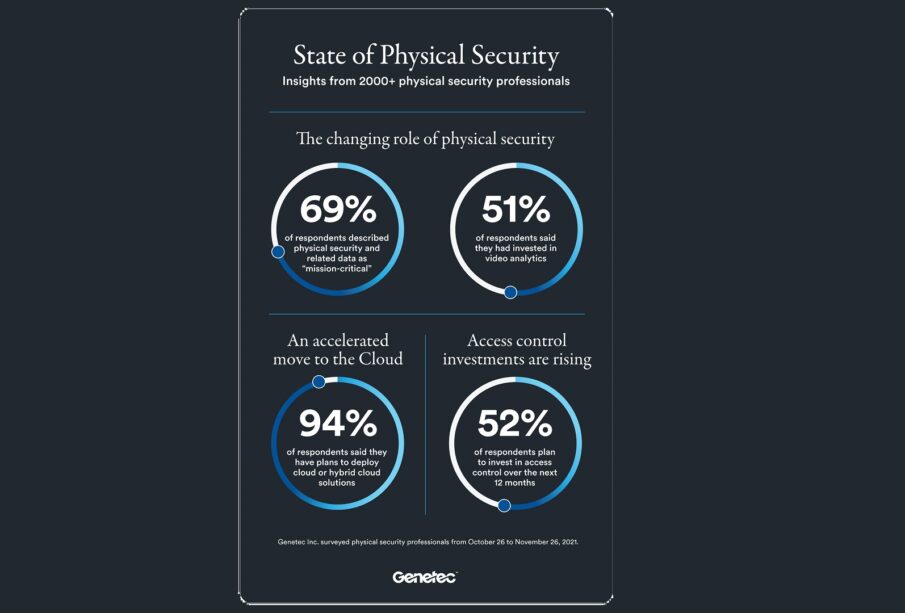
Genetec, a technology provider of unified security, public safety, operations, and business intelligence solutions, shared the results of its state of the industry report. Based on insights from over 2,000 physical security leaders from around the world, the report looks at how the role of physical security continued to evolve in 2021 as organizations adapted to changing conditions.
The changing role of physical security
Physical security continues to evolve from being seen as a tool for mitigating risk, to playing a much more significant role in organizations’ digital transformation.
The survey showed that more than two-thirds (69%) of respondents described physical security and related data as “mission-critical”. Larger organizations in particular are increasingly seeing value in the data gathered by their physical security systems with over 46% saying they use their security systems as a way to “improve overall business efficiency, productivity and asset optimization”.
Several survey respondents commented that they intended to invest in data management solutions to advance or improve the functionality of their physical security environment in the coming 12 months. The survey revealed that an increasing percentage of organizations (36%) are investing in unified solutions to enable the ease of maintenance, visibility, and data collection across all their systems to improve functionality and operations. This compares to 31% in the 2020 survey. Over half of all respondents (51%) also said they had invested in video analytics to improve the functionality of existing deployments and digitally transform their business processes.
“Before the pandemic, physical security’s role in business intelligence and operations was already growing, but over the last two years, it has proven to be a strategic asset in coping with a variety of challenges,” said Pervez R. Siddiqui Vice President, Offerings and Transformation at Genetec Inc. “As we emerge from the pandemic, organizations will contend with three undercurrents; changes in the physical dimension of work as workspaces evolve into hubs for collaboration and cohesion, workflow automation of the mundane in a bid to drive productivity and retention, and board-level interest in achieving operational resilience through integrated risk management.”
An accelerated move to the Cloud
With the pandemic forcing restricted access to physical sites, cloud-based solutions that enable organizations to remotely monitor video, control cameras, assess system health, perform maintenance, and update firmware/software have become invaluable.
The survey showed that 45% of larger organizations (with over 1,000 employees) have already adopted cloud solutions which is a significant increase compared to 2020 when only 26% of respondents said they had begun their cloud journey. A massive 94% of respondents said they have plans to deploy cloud or hybrid cloud solutions in the long term. However, different regions have varying conditions for hybrid deployment. Only 14% of respondents in the Middle East indicated that at least 25% of their physical security environment is cloud or hybrid cloud. This could be due to strict regulatory environment in some Middle Eastern countries as respondents from the Middle East were most likely to select “hosting data outside your country” as a reason which deters them from deploying cloud security solutions.
“The adoption of cloud and hybrid cloud solutions is rapidly accelerating in the security industry,” said Christian Morin, Vice-President Product Engineering and CSO at Genetec Inc. “While many physical security departments were hesitant to consider cloud connected solutions in the past, they now better understand the benefits these solutions bring and how it can help them to better utilize their resources to achieve their respective business goals while minimizing their overall operational complexity.”
Access control investments are rising
When asked about the type of solutions they were planning to invest in to advance or improve their physical security environment in the next 12 months, over half of respondent (52%) picked access control.
“Legacy access control systems use outdated technology that leaves them vulnerable to cyber threats, and can cause damage beyond the door,” commented Thibaut Louvet, Director, Access Control Product Group at Genetec. “So it is reassuring to see that organizations are taking the necessary steps to migrate their access control systems to more modern, cyber secure access control systems.”
















